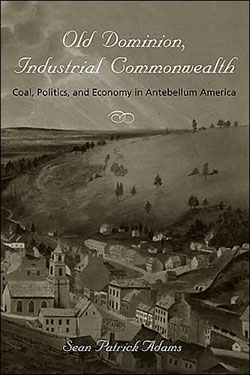Old Wealth, Common Wealth


By 2006, Virginia had not had an effective transportation plan for twenty years. Yet Norfolk and northern Virginia are among the fastest-growing regions in the nation. Everyday an avalanche of cars and trucks engulf its antiquated roadways. A new governor had called for an expansive program of transportation improvements to address the crisis. The legislature, however, was mired in a controversy between moderates and conservatives over funding the governor’s program with a permanent revenue stream from new, mostly indirect taxes. Conservatives refused to budge on raising taxes. What Sean Patrick Adams might call a political economy of state action—or inaction in this case—was crippling Virginia’s capacity to address one of the greatest threats to its economic growth and well-being.
In Old Dominion, Industrial Commonwealth, Adams demonstrates that the impasse of the current imbroglio has deep historical roots. Explaining the troubled present is not Adams’s objective, but his book provides a powerful tool for doing just that. His focus lies on coal, not transportation. Although the book’s subtitle limits its scope to antebellum America, its concerns encompass the entire nineteenth century. And they include not only Virginia but also Pennsylvania and that area of Virginia that became West Virginia. Key to Adams’s thesis is the nineteenth-century transition from localized economies, manageable by state governments, to an emerging national economic order in which huge and highly capitalized corporations overwhelmed the states and the limited public sphere they represented.
In the decades before the Civil War, contrasts between Pennsylvania and Virginia demonstrate Adams’s central idea: the political economy of state institutions shaped the course of economic development. Simply put, Pennsylvania emerged as one of the nation’s industrial powerhouses and Virginia did not because of different approaches to exercising the economic powers of the state in the interest of commercial development and the general good. The difference was not the fault of natural endowment. Virginia, like Pennsylvania, possessed important coal reserves in its piedmont region within the immediate market reach of Atlantic port cities. And each state harbored vast reserves of bituminous coal in its western mountains. What separated Virginia from Pennsylvania and condemned the Old Dominion to second-rank industrial status was quite simply slavery. Slavery dominated the concerns of tobacco planters east of the state’s Blue Ridge, and these men dominated the legislature.
At this point the past begins to resonate with the present. Fearful that the costs of economic development and industrial growth would be paid for by property taxes—and slaves, of course, were property—easterners crippled development projects like the James River and Kanawha Company’s efforts to connect tidewater markets to the Ohio River through a series of canals, turnpikes, and navigation improvements. Because transportation development in the west did little to benefit the agricultural economy of the east, planter elites refused to establish a permanent revenue stream for the improvement of the interior. Conservative, antitax principles also limited the economic impact of other endeavors such as a state geological survey or a general incorporation act—the latter would have eased the incorporation process by freeing it from the political machinations of the state legislature.
The legislative environment and political economy of Pennsylvania seemed a world away, separated by the gulf of modernization. Differences emerged from more than the absence of slavery. They also came from the presence of a diverse population and a political culture shaped by varied interests and a more inclusive conception of the public will. Thus when colliers and farmers in the state’s central region needed canals to get goods to market, the state itself built them. Pennsylvania’s geological survey—not only conducted simultaneously with its southern neighbor’s but also by the brother of the Old Dominion’s state geologist—was put to the service of developing the commonwealth’s mineral and agricultural resources. Although interest-based politics often confounded attempts to reform the process of corporate chartering, Pennsylvania eventually established an effective program of fostering corporations as the most powerful, albeit private, means of industrial development.
The clarity of the Pennsylvania-Virginia comparison dissolved in the postbellum economic world. Both states succumbed to the forces of economic nationalization as large corporations with national political clout gained control of the American economy. The contrast was further complicated by the emergence of West Virginia on that side of Virginia’s sectional faultline containing the old state’s vast store of bituminous coal. But with the demise of the Radical Republican political movement that created the state and with the emergence of conservative local politicians eager to reestablish a political culture of deference, the state withered while national energy and transportation corporations ransacked its mineral resources.
Meanwhile, the fact that Virginia had a coalfield just west of Richmond disappeared from public memory. The triumph of conservative Democrats by the end of the 1880s, for all practical purposes, put a political economy of state action in the deep freeze. Although Adams’s story stops at about this point, the extent of this chill in economic development was evident again in the 1950s when the Virginia legislature, faced with one of the worst, most poorly funded educational systems in the nation, adopted a requirement that all surplus tax revenues go back to taxpayers instead of toward improving public life. The deadening effects of massive resistance to school desegregation and civil rights—especially when programs for the social and economic betterment of the state’s poor population depended upon tax revenues—was only further evidence for the persistent power of a political economy and political culture born in slavery. And needless to say, many Virginians in the state’s transportation-starved population centers might feel enslaved today to a political culture deeply suspicious of the public sphere and resentful of any public spending to support it.
This article originally appeared in issue 6.4 (July, 2006).
Warren R. Hofstra is professor of history at Shenandoah University in Winchester, Virginia, and writes on landscape, regional history, and Virginia broadly construed.